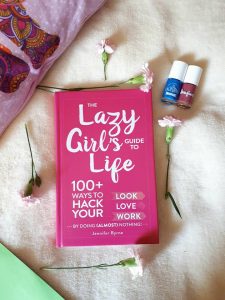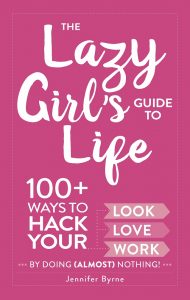The “Lazy Way” To Write a Humorous Self-Help Book (Hint: There Really Isn’t One)
 It’s either perfect or ironic that I ended up writing a humorous self-help guide about being lazy. Perfect, because I happen to be one of the laziest people I know, and therefore speak from experience. Ironic, because writing a book isn’t really the kind of project where laziness comes in handy. Probably it’s a little bit of both.
It’s either perfect or ironic that I ended up writing a humorous self-help guide about being lazy. Perfect, because I happen to be one of the laziest people I know, and therefore speak from experience. Ironic, because writing a book isn’t really the kind of project where laziness comes in handy. Probably it’s a little bit of both.
Actually, the process of writing the book was very instructive for me. The concept of “The Lazy Girl’s Guide to Life” is the use of hacks and work-arounds that allow the “lazy girl” to get things done with minimal effort. In a way, though, it helped me to genuinely overcome my own laziness to some extent.
I realized that some of my lazy writing habits – like staring at a blank computer screen for hours – aren’t really about laziness at all. Instead, like many writers, I was just overwhelmed by the hugeness of the task, and somehow expected an entire book to just flow out of me like magic. I was viewing it in a very “all or nothing” way, and I was keeping myself stuck.
My first piece of “how to” advice on how to write how to books is this:
Break it into small parts.
For my book, this was really intuitive. I just sketched out several difficult life challenges and gave each problem its own heading and section. For example, one problem might be “You Want Killer Legs, But Hate Leg Day at the Gym.” I defined the problem, did a lighthearted section setting the scene (“It’s miniskirt season, and you have a pair of legs that won’t quit. You kind of wish they would quit, though, because you’re seriously thinking of firing them.”), and then provided advice.
I had over 100 of these problems, so that structure really helped me tackle the book in small bits. I also grouped the situations and problems into different areas of life, such as “Looking Presentable,” “Sucking Up Social Situations,” or “Dragging Yourself Through the Workday.” Each problem would go into one section of the book. Every time I finished writing advice for a problem, I allowed myself to be proud, and when I finished a whole section, I was SUPER proud. Time for a reward!
Obviously, a novel or memoir wouldn’t be organized in exactly this way, but they have their own structures to follow. The idea is, whatever you’re writing, divide the task into small, manageable parts. I really can’t stress this enough – it might actually be the ultimate advice for all of life.
Know what motivates your character.
 You might think there is no such thing as a “character” when writing self-help or how-to. Well, guess what? You guessed it – WRONG! There ARE characters in these genres; they might just be working invisibly behind the scenes! In my book, the implied “protagonist” of the would be the “Lazy Girl” of the title, aka, my target reader.
You might think there is no such thing as a “character” when writing self-help or how-to. Well, guess what? You guessed it – WRONG! There ARE characters in these genres; they might just be working invisibly behind the scenes! In my book, the implied “protagonist” of the would be the “Lazy Girl” of the title, aka, my target reader.
It wasn’t too tough to jump into that character’s head, because, as I mentioned, I am very lazy. Once you have the scaffold of your book’s structure, you can build onto that structure with character, and imagine the character in the situations you’ve outlined. My “character” is a young woman who has been thrust into the often annoying and sometimes overwhelming world of adult responsibility.
Our heroine might be nostalgic for simpler days, when she could just have fun and not have to navigate these adult challenges. The point is, even though this “character” is never actually mentioned in my book, her reactions and motivations are essential to how I frame these problems, and how I present the solutions.
Put your character into a story.
It’s surprising how much humorous self-help can resemble a work of fiction. You’re presenting imaginary situations, and basically telling a story around how your imaginary character would handle them. While fiction takes a situation that didn’t happen and says, “This Happened,” a how-to or self-help guide takes a situation that didn’t happen and asks, “What Should You Do If This Happens?”
Of course, in how-to and self-help, the advice answers that question, and tells the reader what ideally should happen to achieve the best possible outcome. But as in most kinds of writing, the “plot” in self-help is the problem, and the advice is the way to overcome that problem.
So, if my lazy girl should find herself hosting a last-minute dinner party and hasn’t found time to cook, the book will explain how this situation is resolved by telling the reader how to handle it (Can you say, “Whole Foods?”). And unlike fiction, self-help at least gives you the instructions and tools for creating a happy ending, every single time.
—
Jennifer Byrne is the author of The Lazy Girl’s Guide to Life: 100+ Ways to Hack Your Look, Love, and Work By Doing (Almost) Nothing! (Adams Media, a division of Simon & Schuster), who writes humorous essays, satire, and journalism. Her writing has been published online in The New Yorker, The Huffington Post, The Rumpus, The Hairpin, The Second City Network, National Lampoon and more. Follow her @JenniferAByrne.
 About The Lazy Girl’s Guide to Life
About The Lazy Girl’s Guide to Life
100+ Ways to Hack Your Look, Love, and Work By Doing (Almost) Nothing!
This collection of humorous life hacks features 100 easy, low-commitment solutions to the everyday problems of the twenty-something woman.
Do you have a lot to do but can’t seem to bring yourself to do it? The Lazy Girl’s Guide to Life can teach you how to get things done with as little effort as possible. Learn to simplify your beauty routine, keep up with your friendships, hack the dating game, and get by in the corporate world with these easy, low-commitment suggestions. You’ll find over 100 solutions to your most common problems, including:
-Smoothing out frosting on store-bought cupcakes so they look homemade
-Hiding dirty dishes in a soapy sink before company arrives
-Washing and styling bangs (only) to avoid the limp hair look…
Category: Contemporary Women Writers, How To and Tips























